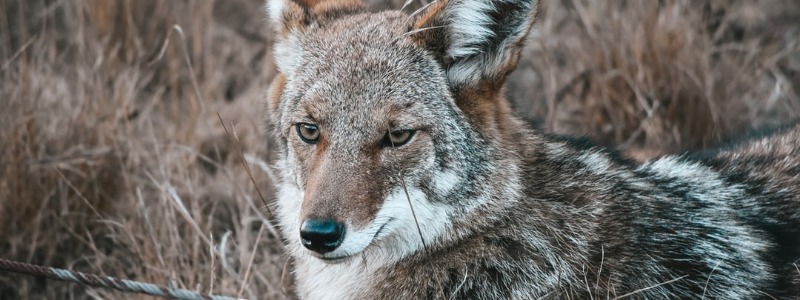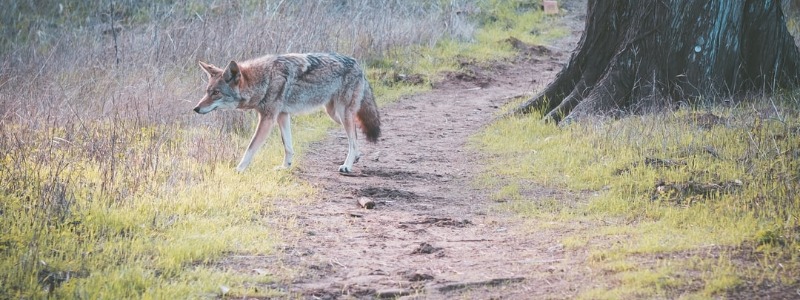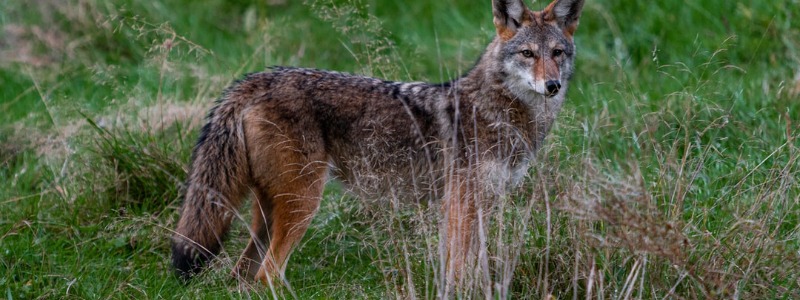Coyotes in Dripping Springs
Coyotes (Canis latrans) are sometimes known as prairie wolves though they are smaller than wolves and are one of the three different types of wild canids (dogs) found in North America. Their name comes from the Aztec word for the species, coyotl. The scientific name Canis latrans literally means “barking dog.”
The males are typically heavier than females. Their coloration is gray, brown or tan above, whitish underneath. The reddish, bushy tail, tipped in black, is usually carried low, held straight out behind or between the legs. The muzzle is long, slender, and pointed, the eyes yellow with round pupils, the ears large and erect; the lips black-pigmented. Females bear an average of five to ten pups annually. Coyotes have exceptional senses of smell, vision and hearing.
Coyotes are adaptable; they can live in a wide variety of climates and conditions — in suburbia and wilderness. They favor brushy habitat and the edges of fields near forests.
Why Are There Coyotes Outside My House?
Coyotes are known to wander into neighborhoods in search of easy food sources. And although coyotes are omnivorous, meat accounts for 90% of their diet. Most prefer to live in areas where they can easily obtain regular, meat food sources.
Coyotes are omnivorous and eat whatever is handy, including meat, garbage, insects, rodents, rabbits, birds, deer, and carrion. Fruits and berries can make up a large portion of their diet. Coyotes are important in controlling rodents: 80% of their diet consists of rabbits, squirrels, gophers, mice, and rats. Normally solitary hunters, they sometimes hunt in pairs and rarely in packs to bring down larger prey. Coyotes can run up to 45 mph for short distances and swim well. They are active both day and night, though chiefly nocturnal. They have a life span of 10 to 15 years in captivity and 8 to 10 years in the wild. Coyotes have been known to interbreed with domestic dogs.

The coyote’s most characteristic vocalizations are shrill yips and howls. Howling is often a group effort and may function as greetings between individuals or territorial claims. The coyote was “song dog” to the American Indians.
Humans are the coyote’s chief enemy. It has been estimated that 30 to 50 percent of all adult coyotes die each year from human-related causes. The coyote’s reproduction level appears to be directly correlated to attempts to control its population. Larger litters seem to be born in areas where intensive efforts at extermination or control have been undertaken. If coyotes in a certain area are killed, die or are relocated, the remaining coyotes will fill the vacancies, either with larger litters or by allowing outsiders to move into the area. This species has survived hunting, trapping, shooting, poisoning and other attempts of eradication and remains a strong link in the ecological cycle.
Coyotes are actually helpful to ranchers and farmers because they kill destructive, vegetation-eating rodents whose burrowing holes have injured many cows and horses. Coyotes love insects and have saved many a farm from massive large insect invasions (grasshoppers). Coyotes help keep the balance of nature in order. Natural rodent control is preferable to man-made poisons and inhumane traps.
Coexisting with Coyotes
Coyotes are most active at dawn and dusk, but can be seen hunting or traveling during the day. They communicate using a variety of vocalizations. Coyotes range in size from 25 to 40 pounds, but their thick coat can make them appear larger. Coyotes are naturally wary of humans, but living in close proximity to humans and finding easy food sources with few adverse repercussions can cause coyotes to become bolder and create potentially dangerous situations.

“In urban areas, coyotes prefer wooded patches and shrubbery, which provides shelter to hide from people. Our research has found that within the urban matrix, coyotes will avoid residential, commercial, and industrial areas but will use any remaining habitat fragments, such as those found in parks and golf courses.” – Urban Coyote Research Project
Due to the rapid loss of habitat by development, many coyotes have found themselves forced to cohabit with humans. We humans need to learn to coexist with this native species. The problem of dealing with the urban coyote will not be solved by extermination; this would just disturb the eco- system of the area. Education and coexistence are the solution.
How to Avoid Conflicts with Coyotes
1. Do not feed the coyotes. They can easily become dependent on human food sources.
2. Never leave pet food outside.
3. Never discard edible garbage where coyotes can get to it.
4. Secure garbage containers and eliminate their odors. Use a small amount of ammonia or cayenne pepper in the garbage to discourage scavenging.
5. Restrict use of birdseed. Coyotes are attracted to it and to the birds and rodents that use the feeder.
6. If possible, eliminate outdoor sources of water.
7. Trim and clear near ground level any shrubbery that provides cover for coyotes or prey.
8. Use fencing to help deter coyotes. The fence must be at least six feet tall with the bottom extending at least six inches below ground level. Augment your existing fencing with outwardly inverted fencing, hot wire, or cement blocks and large rocks buried outside the fence line to prevent animals from digging into your yard.
9. Actively discourage coyotes by making loud noises and throwing rocks to make them leave.
10. Pick that fruit as soon as it ripens and keep rotted fruit off the ground.
11. Battery operated flashing lights, tape recorded human noises, scattered moth balls and ammonia-soaked rags strategically placed may deter coyotes from entering your yard.
12. Keep cats and small dogs indoors, allowing them outside only under strict supervision.
13. Keep chickens, rabbits and other small animals in well protected areas and in sturdy cages at night. Cages made of chicken wire are meant only for keeping small animals contained. They will not keep desperate coyotes or other predators from entering. Stronger gauge wiring is a necessity in protecting these small animals.
14. Coyotes are attracted to and can mate with unspayed or unneutered domestic dogs. Unspayed female dogs in season will attract male coyotes, and unneutered male dogs can be lured away by the scent of a female coyote in her ovulation cycle. There have been cases of male dogs being lured by the female coyote’s scent and killed by male coyotes. It is strongly advised that people living in areas frequented by coyotes have their dogs spayed or neutered to prevent such tragedies from occurring.
15. Trapping and relocation of coyotes is not a recommended or viable alternative. Coyote pups, although weaned at an early age, may remain with their mother into their second year, often helping the mother care for her newest litter. Disruption of this “pack” can mean devastation for the whole group or cause disoriented or suddenly orphaned coyotes to deviate from the norm and prey on easy game (small dogs, rabbits, cats, chickens, etc.). Wild animals are territorial and like species will simply take over the area vacated by the relocated or dead animal.
If you don’t mind sharing your space with coyotes, enjoy observing them with binoculars when they visit. Coyotes are shy and a lot of patience is required to observe them. Coyotes will appear most often during the hours close to sunrise and sunset. In urban areas, coyotes may be more bold. Do not attempt to approach a coyote. It will likely run away, but any cornered or frightened wild animal can be dangerous.
Humane Coyote Control & Removal
A coyote, like all wildlife, is a natural and normal part of the natural environment. Coyotes, in their natural habitat, are significant contributors to a healthy ecosystem! Keeping coyotes away from homes is not only good for you; it is also beneficial to the environment and the coyotes themselves.

